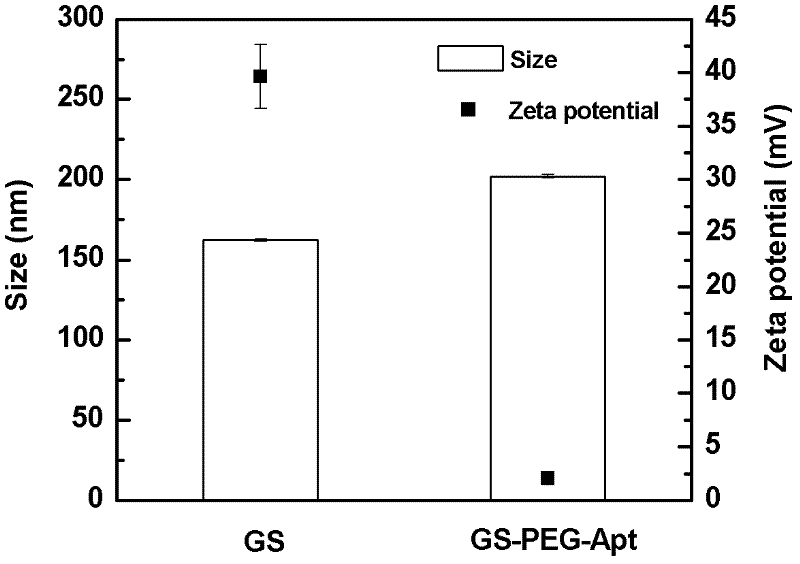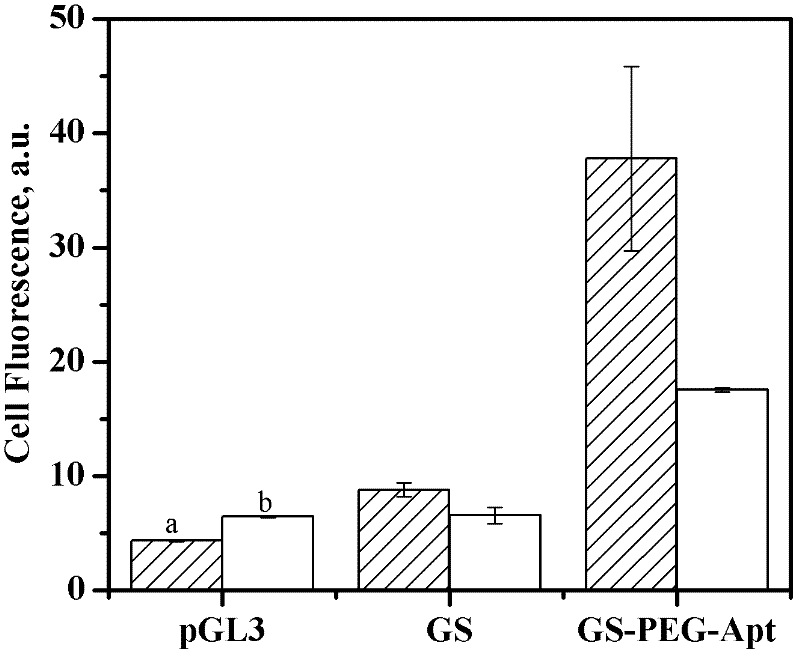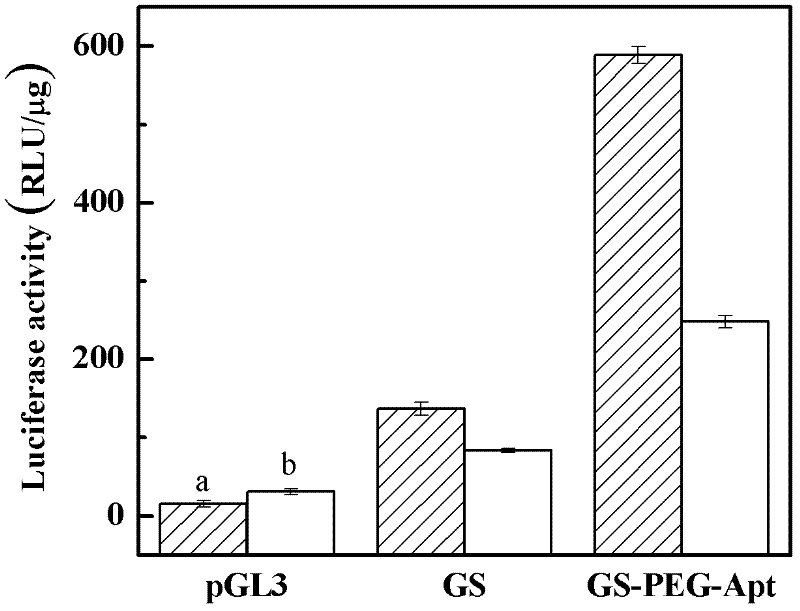Method for realizing surface modification of tumor targeted nonviral vector and application thereof
A non-viral vector and surface modification technology, applied in the field of non-viral vectors, can solve the problems of limited clearance speed and application, and achieve the effects of no immunogenicity, high transduction efficiency, and no cytotoxicity.
- Summary
- Abstract
- Description
- Claims
- Application Information
AI Technical Summary
Problems solved by technology
Method used
Image
Examples
Embodiment 1
[0034] 1) Preparation of gelatin-siloxane nanoparticles (GS)
[0035] 0.2 g of gelatin was dissolved in 20 mL of acetic acid solution with pH 3 and stirred at 50° C. for 30 min. Then, 0.2 g of 3-(2,3-glycidoxy)propyltrimethoxysilane was added to the above 1% gelatin solution. After the reaction solution was stirred and reacted at 30°C for 6 hours, ammonia water was added to adjust the pH of the solution to 9, and the reaction was continued for 12 hours to obtain a milky white suspension. The milky white suspension is subjected to high-speed centrifugation (20,000 rpm, 15 min, 30° C.) to obtain a white precipitate. The white precipitate is washed twice with distilled water to obtain gelatin-siloxane nanoparticles (GS).
[0036] 2) Polyethylene glycol modified gelatin-siloxane nanoparticles (GS-PEG)
[0037] Add 1-ethyl-3-(3-dimethylaminopropyl)-carbodiimide (EDC), N-hydroxysuccinimide (NHS) and α- Amino-ω-propionic acid-polyethylene glycol (NH 2 -PEG-COOH). EDC: NHS: NH 2 The mol...
Embodiment 2
[0042] In the pH 8.0 sodium carbonate buffer, add 1-ethyl-3-(3-dimethylaminopropyl)-carbodiimide (EDC), N-hydroxysuccinimide (NHS) and α -Amino-ω-propionic acid-polyethylene glycol (NH 2 -PEG-COOH). EDC: NHS: NH 2 -The molar ratio of PEG-COOH is 4.5:4.5:1, shake the reaction for 4h, and then mix it with GS dispersed in pH8.0 sodium carbonate buffer to make NH 2 -PEG-COOH and the amino group on GS (-NH 2 The molar ratio of) is 1:1. After continuing the shaking reaction for 4 hours, the milky white suspension was subjected to high-speed centrifugation (14,000 rpm, 20 min, 20° C.), and a white precipitate was obtained. The white precipitate was centrifuged and washed with distilled water three times to obtain polyethylene glycol-modified gelatin-siloxane nanoparticles (GS-PEG).
[0043] Disperse GS-PEG in a sodium carbonate buffer of pH 8.0, and add 3-(2-pyridinedimercapto) propionate n-hydroxysuccinimide (SPDP) to make SPDP and the amino group on GS-PEG ( -NH 2 The molar ratio of...
Embodiment 3
[0046] Preparation of fluorescently labeled luciferase plasmid pGL3 and GS complex: mix the fluorescent marker propidium iodide (PI) with the pGL3 plasmid at a mass ratio of 0.7:1 evenly in distilled water, and let it stand for 20 minutes at room temperature in the dark. A fluorescently labeled plasmid (pGL3-PI) was obtained. GS and plasmid pGL3-PI were mixed in distilled water at a mass ratio of 50:1 at 25°C, vortexed for 30 seconds, and then left to stand for 1 hour to obtain a gelatin-siloxane nanocomposite suspension (GS / pGL3-PI).
[0047] In the pH 9.0 sodium carbonate buffer, add 1-ethyl-3-(3-dimethylaminopropyl)-carbodiimide (EDC), N-hydroxysuccinimide (NHS) and α -Amino-ω-propionic acid-polyethylene glycol (NH 2 -PEG-COOH). EDC: NHS: NH 2 -The molar ratio of PEG-COOH is 3:3:1, the reaction is shaken for 4h, and then it is mixed with the GS / pGL3-PI nanocomposite dispersed in the pH9.0 sodium carbonate buffer to make NH 2 -PEG-COOH and the amino group on GS (-NH 2 The mo...
PUM
 Login to View More
Login to View More Abstract
Description
Claims
Application Information
 Login to View More
Login to View More - R&D Engineer
- R&D Manager
- IP Professional
- Industry Leading Data Capabilities
- Powerful AI technology
- Patent DNA Extraction
Browse by: Latest US Patents, China's latest patents, Technical Efficacy Thesaurus, Application Domain, Technology Topic, Popular Technical Reports.
© 2024 PatSnap. All rights reserved.Legal|Privacy policy|Modern Slavery Act Transparency Statement|Sitemap|About US| Contact US: help@patsnap.com










